Letters from Lodi
An insightful and objective look at viticulture and winemaking from the Lodi
Appellation and the growers and vintners behind these crafts. Told from the
perspective of multi-award winning wine journalist, Randy Caparoso.
Silicon Valley Bank's 2021 State of the U.S. Wine Industry report focuses on immediate and unimaginable challenges
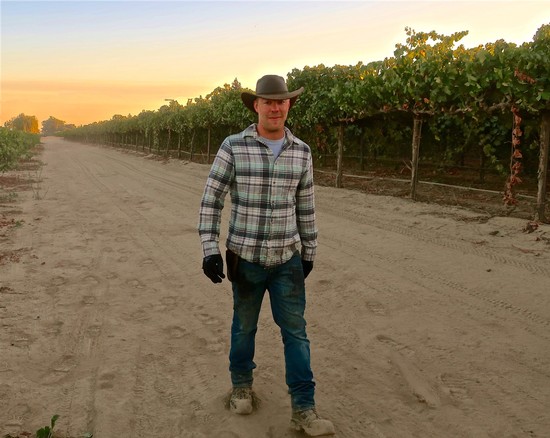
Michael Klouda Wines owner/winemaker Mike Klouda walking among ancient and trellised vines during harvest on the east side of Lodi's Mokelumne River AVA
In Silicon Valley Bank's yearly State of the U.S. Wine Industry report released last month (January 2021), the focus was on, naturally, the "unimaginable challenges" of 2020.
Silicon Valley Bank has served as one of the major lenders to the grape and wine industry over the past quarter-century (its website cites over $4 billion in loans), and its yearly report is meticulously assembled each year by Rob McMillan, Executive Vice President and Founder of the SVB Wine Division.
Writes McMillan, "2020 will go down as the year in which we answered the heretofore rhetorical question, what else can go wrong?" At the same time, says McMillan, "We can also admire the year for the way the wine industry — known for its glacial adaptation to change — took on the obstacles of a worldwide pandemic head-on and found new approaches to sell.
"Those adjustments allowed about a third of the wineries to have better sales than their prior year, while larger producers improved their abilities to get wine into bottles, trucks, and grocery stores before sellouts. The lessons learned will shape strategy for the next decade."
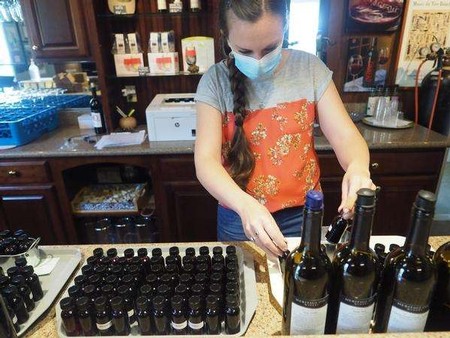
Preparation in Lodi's Heritage Oak Winery tasting room in accordance with guidelines set by San Joaquin County (photograph by Calixtro Romias, courtesy of The Stockton Record)
The SVB begins by citing its previous year's report warning of an acute oversupply of grapes and sales growth of wine, at the beginning of 2020, stagnating at "near zero for the first time since 1993 and negative in the first two months of the year."
The industry experienced considerable and complex changes, however, starting in March 2020 when stay-at-home orders were imposed in major markets across the country. Two of the almost instantaneous results: on-premise (i.e., restaurants) wine sales plummeting, and off-premise sales (i.e., retail) shooting up to historic heights.
The SVB report cites these figures assembled by Nielsen comparing the volume as well as the value of retail sales between 2020 and 2019:
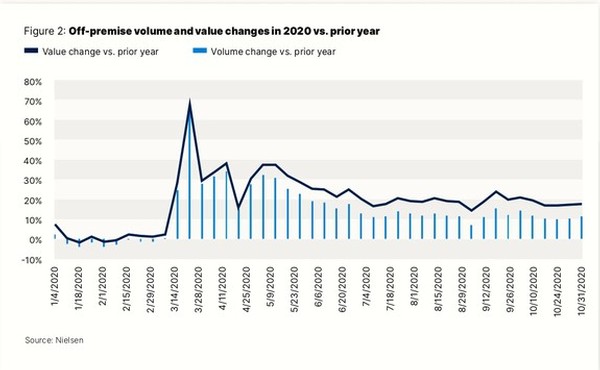
And long-term retail wine sales by cases and dollars:
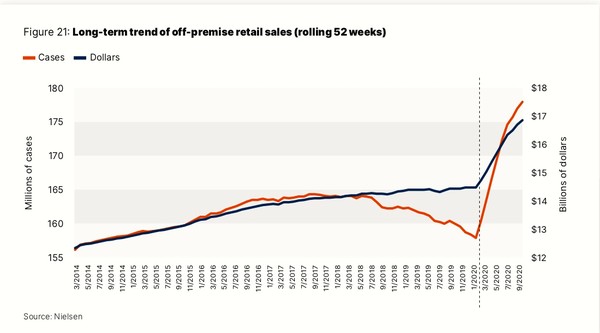
This Nielsen finding demonstrates the loss of wine sales caused by restaurant closures:
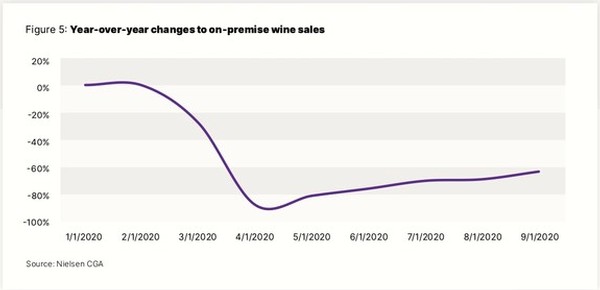
"Through November 2020," writes McMillan, "over 2.1 million jobs were lost in the restaurant business, and 16% of restaurants (one in six) have been forced to close."
There is, however, one bit of good news for the California winegrowing industry, and that is that the grape crush, in oversupply just two years ago, has at least come back into balance with consumption of California wines, triggered by increased on-premise sales in 2020.
Updated figures assembled by SVB with data supplied by the California Wine Institute and the California Department of Food and Agriculture:
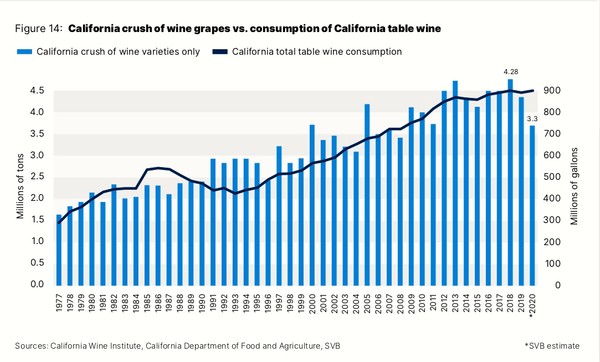
According to McMillan, however, reports based on grocery channel sales are deceptive: "The consumer really hasn't [our italics] been consuming more wine." The wine industry still needs to focus on broader issues in order to "recover the growth rates from past years that allowed everyone to prosper."
Nonetheless, there is a general expectation that 2021 will evolve differently as vaccinations are distributed and the chances of an immunized population increase. Warns McMillan: "The post-COVID world won't be the same one we left in early 2020. there will be many permanent changes we will need to consider, such as the shift to working from home, the increasing relocation of consumers to the suburbs, and the acceleration of consumer online sales, which will take sales away from other channels. Even the best-run wineries of 2019 won't find the same level of success in 2021 unless they evolved in 2020 and continue to do so in 2021.
"Restaurant sales will return in 2021 when restrictions are loosened... however, we don't see a return to pre-COVID on-premise conditions for years — if ever. In the longer term, the permanent closures of restaurants will result in reduced selling opportunities on-premise... The expectation for many restaurants is that their wine inventories will be minimized and streamlined into smaller offerings."
While many wineries have made a successful transition to DTC (i.e., direct-to-consumer) sales and strengthened their supply lines to retail markets over the past nine months, SVB cautions that there are still inexorable changes in consumer preference and behavior that need to be addressed.
Based on SipSource figures, this graph demonstrates the steady movement of shares and growth rates in terms of varietal preferences:
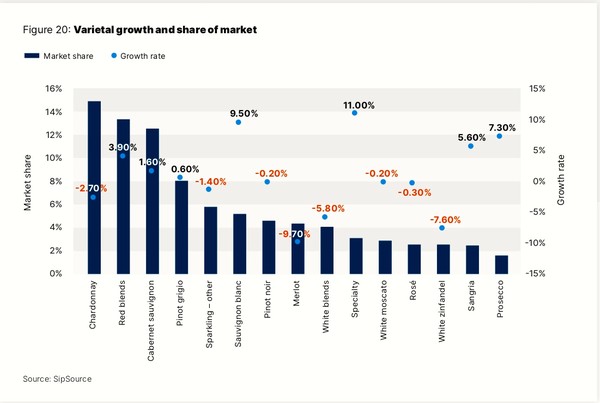
According to SVB: "While Chardonnay is still the most popular varietal, its growth rate is negative for the second year in a row at negative 2.7% on a trailing 12-month basis, while misunderstood Merlot shows the worst decline at almost 10%. And the bloom is officially off the rosé [category] this year, with a growth rate slightly below zero."
Regarding red wine blends, currently the second largest selling category of wine after Chardonnay: "Red blends have made a comeback in 2020. After a negative growth year in 2019, the red blend category is back to a respectable 3.9% growth." Otherwise, these figures show that Cabernet Sauvignon and Pinot Grigio continue to show strength, while interest in Sauvignon Blanc, sparkling wines such as Prosecco, and Pinot Noir remain significant.
An overriding concern, which SVB has continuously hammered at over the past few years, is the continuing change in generational spending — namely, the market effects of fading boomers, the relative lack of enthusiasm for wine continuously demonstrated Gen Xers, and the even slower embrace of wines among millennials.
This is a snapshot of the U.S. population as of 2019 supplied by the U.S. Census Bureau, with definitions of the age groups of current generations:
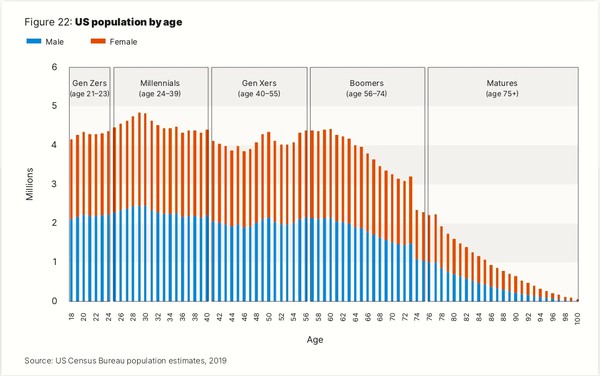
McMillan contends that the crucial issue that needs to be seriously addressed by the wine industry concerns the differences in "values" clearly demonstrated by the different generations, as broken down by SVB:
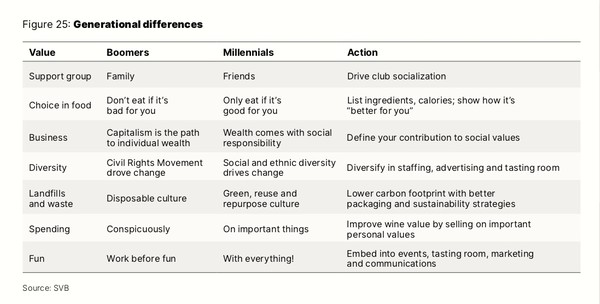
Writes McMillan: "A myriad of rapid shifts in 2020 — the greater numbers of boomers retiring, the increase in the work-from-home sphere, wider use of home delivery, a population shift away from major cities, a recession that has weighed more heavily on lower-level employees and the jarring growth rate of internet sales — have made the reading of trends much more difficult.
"Baby boomers, with 70% of the disposable income and more than 50% of the wealth in the U.S., are still the largest consumers of wine today. But as of this year, with only a single percentage point separating their consumption share from that of Gen X, they can't be considered the dominant group. Consistent with our forecast in this report starting in 2016 and each subsequent year, boomers should cede their top spot to the Gen X cohort in 2021. They are exhibiting changing spending patterns due to age, health, and retirement concerns. The median boomer will reach the normal retirement age of 66 in 2021."
Based upon SVB's own Annual Winery Conditions Survey, this graph reveals how the largest growth of wine consumption over the past four years has occurred with millennials, and how the most significant loss of sales has been among boomers in the 56-74 age group:
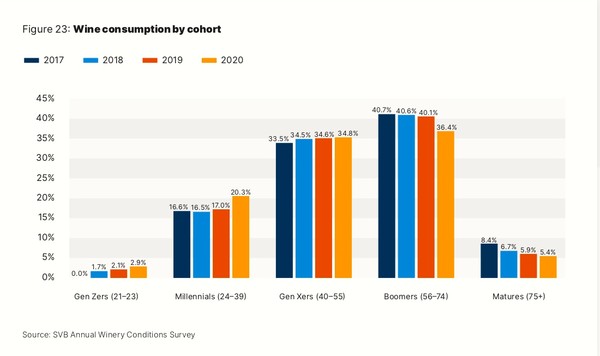
The bad news, according to McMillan, is that "we are living with the sunset of the mature cohort, which has a median age of 88.5. Their numbers are in decline due to mortality and today represent only about 5% of consumption by value and less by volume...
"While the average age of wine drinkers continues to grow older, the neglected growth opportunity is selling to younger consumers, who have different values, are more health-conscious, have lower discretionary income and wealth, and are more ethnically diverse than previous generations."
While Gen Xers currently make up a significant block of today's wine consumers, McMillan remarks that this group "no longer own the biggest growth rate of consumption — passing that honor to millennials as of this year."
It is millennials, says McMillan, who represents "the largest growth opportunity for the wine industry but has just started to show interest in the wine category — at a time when the growth of volume sold in the industry is near zero... This is the cohort that needs to be excited about wine for the industry to see anything close to the growth rates experienced in the 20 years from 1994 through 2014."
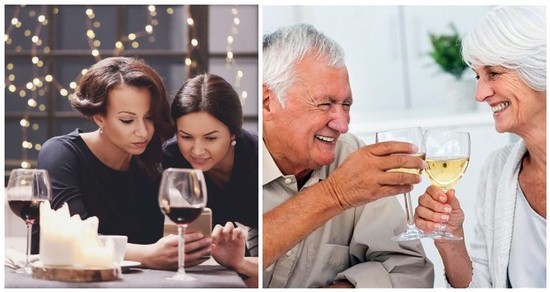
Growing millennial vs. fading boomer generations of wine lovers (images courtesy of The Fix and The Drinks Business respectively)
Selling wine to millennials, contends McMillan, is decidedly different from selling to boomers or even Gen Xers. They simply don't respond to the same pitches. These are people who, for instance, are really and truly concerned with how many calories there are in a 5-ounce glass of wine, how it affects their body shape, or how it squares with their worldview — things that never needed to be mentioned when selling wine to boomers or Xers. These "cohorts" are simply not the same.
McMillan elaborates further on these generational distinctions: "The younger wine consumers now, having lived through the Great Recession and a pandemic, aren't destined to be consumers who will want to show off their wealth. They too will work for a better lifestyle, but they want to know what those who have wealth are contributing to a better world in some way, and instead of bragging about price, they would rather talk to friends about the good work that a brand and its owners are taking.
"In addition to sustainability, health, and environmental issues, which have long been important to younger generations, today's social justice, equity, and diversity concerns are driving these consumers to place unprecedented pressure on companies to adopt these issues into their brand platforms. The social intersection between a brand and the consumer is increasingly connected to the decision to purchase particular products, including wine.
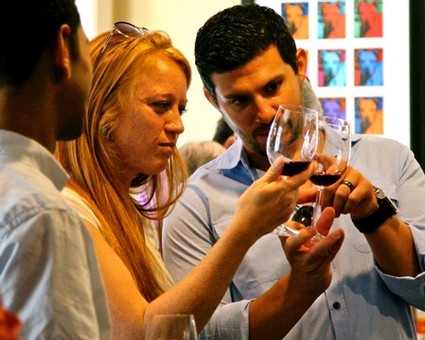
Avid wine lovers (pre-COVID times) in Lodi's d'Art Winery
"Future success in marketing to millennials depends on recognizing the things that are important to them versus what's important to boomers. That's not meant to imply we need to change our core brand or a traditional label, but we have to evolve and leverage the consumer's values when marketing wine."
The recent movement of older generation vineyard and winery owners towards business models embracing sustainability, however, can be a built-in advantage. Writes McMillan: "Many in the wine business use sustainable farming practices and take great care in their winemaking by recycling water, avoiding the use of glyphosate, building and retrofitting with LEED Certification in mind, and being good stewards of their land. Some use biodynamic and organic farming techniques, but little of that shows up in marketing a bottle of wine today, and none of it appears in terminology and graphics the young consumer expects."
As boomers and Xers get older, of course, they, too, become more focused on health and well-being. It's a matter of survival. Says McMillan: "Eating healthy is a critical value of young consumers, and as consumers age, there is ample evidence that boomers are taking their cues from young people, adopting their own health-conscious diets and consumption patterns. In years past, of all alcoholic beverages, wine had scientific evidence to show that it was part of a healthy diet and lifestyle."
Let's drink to that!
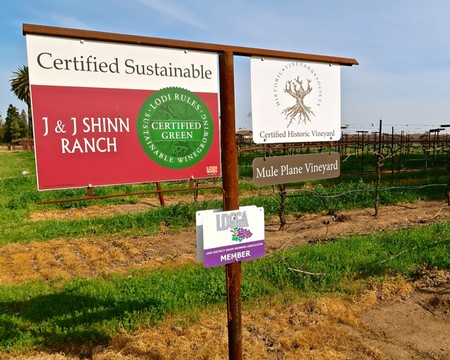
Certified Sustainable and Historic Vineyard Society signs marking the Shinn family's Mule Plane Vineyard on the west side of Lodi's Mokelumne River AVA